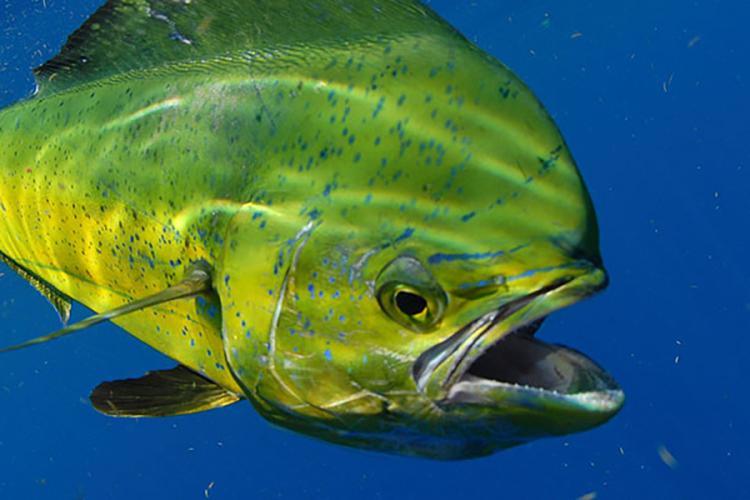Last updated on January 10th, 2024 at 03:34 pm

How Do Dolphinfish Breath? Dolphinfish breath through gills, extracting oxygen from the water as it passes over them. Dolphinfish, also known as mahi-mahi or dorado, are fascinating creatures that inhabit the world’s warm waters.
Their gills draw oxygen from the water to support their respiration, and their muscular tails and sleek bodies allow them to swim across the ocean with ease.
Anglers seek out these magnificent fish because of their vivid colors and graceful leaps, which make them desirable game fish.
In order to better understand how dolphinfish breathe and thrive in their oceanic environment, we will examine their amazing respiratory system.
Knowing the details of their breathing technique demonstrates how adaptive and hardy these amazing animals are.
To discover the mysteries of the dolphinfish’s respiratory system, let’s delve into its depths.
Table of Contents
The Anatomy Of Dolphinfish’s Gills
A dolphinfish’s gills are arranged to maximize surface area for the absorption of oxygen.
The fish’s capacity to draw oxygen from the water for breathing depends on this. A key component of this process is the thin, vascularized gill filaments.
Because of their many little lamellae, they have a vast surface area, which aids in maximizing oxygen extraction.
Gill filaments allow for the easier exchange of carbon dioxide and oxygen while preserving the internal environment of the fish in equilibrium.
Thanks to its ability to use its gills as a specialized respiratory organ, the dolphinfish is able to flourish in its watery home. [How Do Dolphinfish Breath?]
See Also: What Eats A Dolphinfish? Top Predators Revealed
How Do Dolphinfish Extract Oxygen From Water?
The dolphinfish, often called the dorado or mahi-mahi, draws oxygen from the ocean by an amazing process.
In order to maximize oxygen extraction, a mechanism known as countercurrent exchange occurs in which blood flows through the gill filaments in the opposite direction from the water flowing over the gills.
Lamellae play a vital part in this process because their thin structures enhance the amount of surface area that may be used to absorb oxygen.
Dolphinfish are therefore able to effectively take oxygen out of the water, which allows them to flourish in their aquatic environment. [How Do Dolphinfish Breath?]

Environmental Factors Affecting Dolphinfish Respiration
Mahi-mahi, or dorado, as dolphinfish are also called, are interesting animals with unusual breathing systems.
Their respiration is significantly influenced by environmental conditions, specifically water pollution and temperature.
Because dolphinfish are ectothermic, the temperature of the water affects their body temperature. As such, temperature changes in the water can have a big effect on how they breathe.
Dolphinfish, for instance, have higher metabolic and respiratory rates in warm water, which helps them take in oxygen more effectively.
On the other hand, breathing might be affected by cold water as it slows down their metabolic processes.
Moreover, the respiration of dolphinfish may be negatively impacted by water pollution.
The environment of dolphinfish can get contaminated by pollution, including chemical runoff and oil spills, which can result in a drop in oxygen levels and an increase in toxins, making breathing difficult for the fish.
Pollutants can also cause direct harm to their gills, which would hinder the healthy exchange of carbon dioxide and oxygen. [How Do Dolphinfish Breath?]
See Also: Where Can You Get Dolphinfish? Best Places to Find Dolphinfish
Adaptations For Breathing In Dolphinfish
Mahi-mahi, or dolphinfish, have evolved a number of adaptations to enable effective breathing in their aquatic habitat.
For them to survive, breathing patterns and buoyancy control are essential. These fish have evolved a sleek body that makes it easier for them to swim through the water, and their forked tail gives them strong propulsion.
Furthermore, dolphinfish have gills that draw oxygen from the water so they can breathe effectively.
Their breathing habit has evolved to maximize oxygen intake, which is why their respiration and behavioral adaptations are related.
Dolphinfish have evolved more resilient respiratory and buoyant strategies to help them thrive in their watery habitat. [How Do Dolphinfish Breath?]
See Also: Why Is Mahi Called Dolphinfish? The Fascinating Mystery
Frequently Asked Questions Of How Do Dolphinfish Breath?
How Does The Dolphin Breathe?
Dolphins breathe through the blowhole located on the top of their heads. They exhale air and inhale fresh oxygen through this opening when surfacing. This process allows them to breathe while swimming and diving underwater.
How Long Can A Dolphin Hold Its Breath?
A dolphin can hold its breath for 8 to 10 minutes. They are excellent divers. [How Do Dolphinfish Breath?]
Why Do Dolphins Breathe Air But Need Water?
Dolphins breathe air because they are mammals. They need water for their internal functions like digestion, circulation, and reproduction.
Do Dolphins Tell Themselves To Breathe?
No, dolphins do not tell themselves to breathe. They have an involuntary breathing reflex.
Conclusion
It is evident that dolphinfish’s distinct physiology is essential to comprehending how they breathe.
Dolphinfish, with their effective gill systems and swift, controlled swimming, have evolved extraordinary adaptations to help them live long and prosper in their oceanic environment.
These revelations offer an intriguing window into the lives of these amazing animals.

Mr. Das, a certified pharmaceutical scientist, holds a Bachelor of Science in Pharmaceutical Sciences and passionately contributes to dolphin conservation as a member of the committee in Bangladesh.


